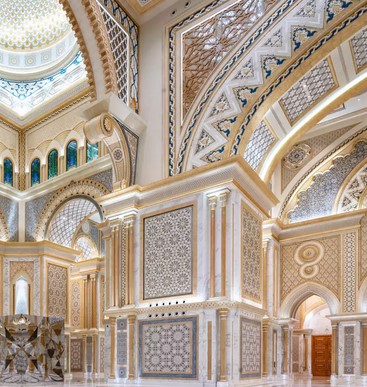Bayan Palace, located in the heart of Kuwait City, is a prominent symbol of the nation’s rich history and cultural heritage. Constructed in the mid-20th century, this stunning architectural marvel serves as the official residence of the Amir of Kuwait and as a vital center for diplomatic and cultural activities. As Kuwait continues to modernize and evolve, the significance of Bayan Palace transcends its physical presence; it embodies the Kuwaiti people’s values, traditions, and aspirations. This article explores the cultural importance of Bayan Palace in modern Kuwait, examining its architectural features, historical context, role in diplomacy, and its place in the national identity of Kuwait.
Historical Context
Bayan Palace, designed by renowned architect A. S. Al-Hamoud, was inaugurated in 1979. It was built to replace the old Al-Salam Palace, which had become increasingly inadequate for the needs of the Kuwaiti ruling family. The construction of Bayan Palace coincided with a period of significant economic growth in Kuwait, fueled by oil wealth. This era marked a transformative phase in the nation’s history, characterized by rapid modernization and development.
The architecture of Bayan Palace reflects a blend of modernity and tradition. It incorporates Islamic architectural elements, such as intricate geometric patterns, arches, and domes, seamlessly integrated with contemporary design. This fusion symbolizes Kuwait’s commitment to preserving its cultural heritage while embracing progress. As such, Bayan Palace has become a representation of the national identity, reflecting a society that values its historical roots and aspirations for the future.
Architectural Features
Bayan Palace is an extraordinary feat of architecture, sprawling over an expansive area with lush gardens, fountains, and meticulously landscaped grounds. The palace is characterized by its stunning façade, white marble and intricate detailing. Using local materials signifies a connection to the land and its resources, while the overall design embodies the grandeur associated with royal residences.
One of the most distinctive features of Bayan Palace is its impressive dome, which serves as a focal point of the structure. The dome is adorned with elaborate decorations that showcase traditional Kuwaiti artistry. Additionally, the palace’s interiors are equally impressive, featuring exquisite chandeliers, luxurious furnishings, and artwork that reflects Kuwait’s cultural heritage. The attention to detail in both the exterior and interior design underscores the importance of craftsmanship and artistic expression in Kuwaiti culture.
Role in Diplomacy
Bayan Palace is not merely a royal residence but a crucial venue for diplomatic gatherings and state functions. It is often the site of official receptions, meetings with foreign dignitaries, and important national ceremonies. Through these events, Bayan Palace plays a vital role in shaping Kuwait’s foreign relations and promoting its position on the global stage.
The palace’s diplomatic significance extends beyond its physical space. It represents Kuwait’s commitment to fostering international cooperation, dialogue, and understanding. The Amir of Kuwait, as the head of state, utilizes Bayan Palace as a platform to communicate Kuwait’s interests, values, and aspirations to the world. This engagement is essential in a region characterized by political complexities and shifting alliances. Bayan Palace is a testament to Kuwait’s diplomatic efforts and desire to play an active role in regional and global affairs.
Cultural Hub
Bayan Palace also functions as a cultural hub, hosting various events celebrating Kuwaiti heritage and promoting cultural exchange. The palace grounds are often used for art exhibitions, traditional performances, and cultural festivals, reinforcing the importance of preserving and showcasing the nation’s artistic expressions. These events allow local artists to share their work with the public and foster a greater appreciation for Kuwaiti culture.
Moreover, Bayan Palace serves as a symbol of national pride. For Kuwaitis, it represents unity, resilience, and the shared values that bind the nation. The palace’s role in cultural events reinforces the importance of community and collective identity, reminding citizens of their rich history and the need to preserve it for future generations.
Educational Initiatives
In recent years, there has been a growing emphasis on educational initiatives centered around Bayan Palace and its history. Guided tours and educational programs are organized to inform visitors about the palace’s architectural significance, historical context, and cultural importance. These initiatives aim to instill a sense of pride and awareness among younger generations, encouraging them to connect with their heritage.
By integrating educational efforts with cultural programming, Bayan Palace serves as a living classroom for those wishing to learn about Kuwait’s past, present, and future. This commitment to education is essential in fostering a sense of belonging and identity among Kuwaitis, particularly in a rapidly changing world.
The Future of Bayan Palace
As Kuwait moves forward into a new era of development and globalization, the future of Bayan Palace remains significant. The palace is a reminder of the nation’s accomplishments while serving as a beacon of hope for the future. Its architectural beauty and cultural importance will continue to inspire generations to come.
In an increasingly interconnected world, Bayan Palace can also promote cultural diplomacy. The palace can foster a greater understanding of the nation’s values and traditions by showcasing Kuwaiti culture and heritage to international audiences. This cultural exchange is essential for building bridges between Kuwait and the global community.
Conclusion
In conclusion, Bayan Palace holds immense cultural significance in modern Kuwait. Its architectural beauty, historical context, diplomatic role, and cultural initiatives make it a cornerstone of the nation’s identity. As Kuwait continues to navigate the complexities of the modern world, Bayan Palace remains a symbol of resilience, unity, and cultural pride. By celebrating its heritage and embracing its role in diplomacy and education, Kuwait can ensure that Bayan Palace remains a vital part of its cultural landscape for future generations. The palace stands not only as a residence for the Amir but also as a testament to the Kuwaiti people’s enduring spirit and commitment to preserving their unique cultural legacy in an ever-changing world.


